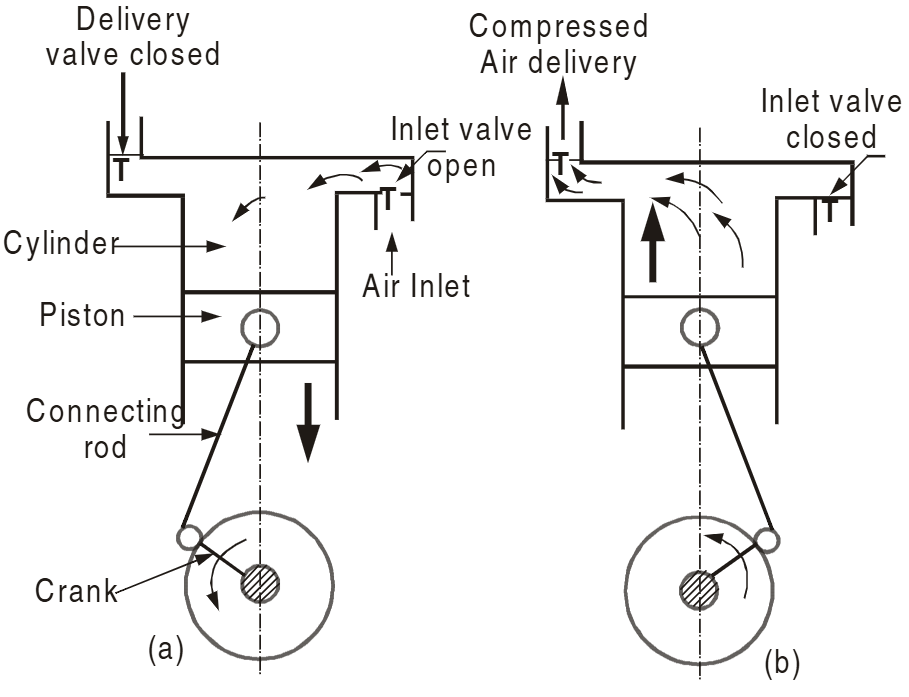A reciprocating air compressor is a type of positive displacement compressor that uses a piston-cylinder mechanism to compress air. It operates by drawing in air, compressing it through a reciprocating motion, and delivering it at high pressure.

Parts of a Reciprocating Air Compressor
- Cylinder – The chamber where air compression occurs.
- Piston – Moves up and down inside the cylinder, compressing the air.
- Crankshaft – Converts rotary motion into reciprocating motion.
- Connecting Rod – Connects the piston and crankshaft.
- Inlet Valve – Allows air to enter the cylinder.
- Outlet Valve – Releases compressed air.
- Flywheel – Maintains smooth operation by reducing fluctuations.
- Cooling System – Prevents overheating (air-cooled or water-cooled).
- Lubrication System – Reduces friction between moving parts.
- Intercooler (for multi-stage compressors) – Cools the air between compression stages.
Working Principle of Reciprocating Air Compressor
The reciprocating air compressor works based on the principle of positive displacement, where air is drawn into a chamber, compressed by a piston, and discharged at high pressure.
Working of Reciprocating Air Compressor
A reciprocating air compressor works on the principle of positive displacement, where a piston moves back and forth inside a cylinder to compress air. The entire working cycle consists of two main strokes:
Suction Stroke (Intake Stroke): The piston moves downward, creating a vacuum inside the cylinder. The inlet valve opens, allowing atmospheric air to enter the cylinder. The delivery valve remains closed to prevent air from escaping.
Compression Stroke: The piston moves upward, reducing the volume of air inside the cylinder. The inlet valve closes to trap the air inside. The air gets compressed as the volume decreases, increasing its pressure. When the air reaches the required pressure, the delivery valve opens, and the compressed air is pushed into the storage tank.
Types of Reciprocating Air Compressors
| Type | Description |
|---|---|
| Single-Acting Compressor | Compresses air on only one side of the piston during one stroke. |
| Double-Acting Compressor | Compresses air on both sides of the piston, increasing efficiency. |
| Single-Stage Compressor | Air is compressed in a single stage and then delivered. |
| Two-Stage Compressor | Air is compressed in two stages for higher pressure output. |
| Multi-Stage Compressor | Uses multiple stages to achieve very high compression ratios. |
| Oil-Lubricated Compressor | Uses oil for lubrication, suitable for heavy-duty industrial use. |
| Oil-Free Compressor | Does not use oil, ideal for medical, food, and clean air applications. |
Advantages of Reciprocating Air Compressors
- High-pressure generation capability.
- Suitable for intermittent and heavy-duty operations.
- Compact size compared to other compressors.
- Low initial investment cost.
- Can handle a variety of gases apart from air.
- Efficient for small-scale applications requiring high pressure.
- Works well in remote areas where continuous electricity supply is unavailable.
Applications of Reciprocating Air Compressors
- Automotive Industry: Used in vehicle air brakes.
- Manufacturing Plants: Powering pneumatic tools.
- Refrigeration and Air Conditioning: Compressing refrigerant gases.
- Petroleum Industry: Gas compression in refineries.
- Medical Industry: Dental air compressors.
- Construction Industry: Powering jackhammers and drills.
- Aerospace Industry: Used in aircraft pneumatic systems.
Disadvantages of Reciprocating Air Compressors
- High maintenance due to moving parts.
- Produces pulsating air flow.
- Generates high noise and vibrations.
- Requires a lubrication system.
- Limited efficiency at continuous high-load operations.
- Bulkier than rotary compressors for the same capacity.
Maintenance of Reciprocating Air Compressors
To ensure long-term efficiency and reliability, proper maintenance is essential:
- Regular Lubrication: Prevents wear and tear of moving parts.
- Checking Valve Condition: Ensures proper air intake and delivery.
- Inspecting Belts and Pulleys: Prevents sudden breakdowns.
- Cleaning or Replacing Air Filters: Prevents dust buildup.
- Checking for Leaks: Avoids pressure loss and inefficiency.
- Cooling System Maintenance: Ensures proper heat dissipation.
Conclusion
Reciprocating air compressors are widely used in various industries for their ability to generate high pressures and work with different gases. They are cost-effective and reliable but require regular maintenance and can be noisy. Despite their limitations, they remain an essential component in many industrial and commercial applications, ensuring a steady supply of compressed air for various tasks.
